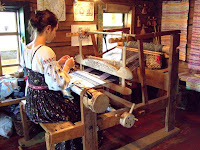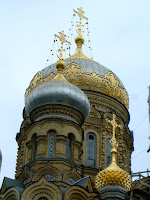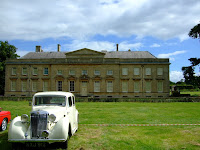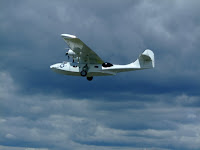 Late in the evening the MS Bunin left the Neva River and set off across the largest lake in Europe, Lake Lagoda, but by the time we woke in the morning we were across the lake and steaming along the river Svir on our way to Mandrogy, arriving just after lunch.
Late in the evening the MS Bunin left the Neva River and set off across the largest lake in Europe, Lake Lagoda, but by the time we woke in the morning we were across the lake and steaming along the river Svir on our way to Mandrogy, arriving just after lunch.Mandrogy is an interesting settlement; completely destroyed in WWII it was resurrected as a craft collective in 1996 to cater to
 the tourist boats plying the river between Lakes Onega and Ladoga. It was officially put back on the Russian maps in 1999. All the buildings are built in the traditional wooden style - some log cabin construction, some sawn timber and all the craftsfolk are dressed traditionally as well. Modern life has not been completely forsaken, as there were plenty of cellphones, credit card readers and the occasional computer in evidence.
the tourist boats plying the river between Lakes Onega and Ladoga. It was officially put back on the Russian maps in 1999. All the buildings are built in the traditional wooden style - some log cabin construction, some sawn timber and all the craftsfolk are dressed traditionally as well. Modern life has not been completely forsaken, as there were plenty of cellphones, credit card readers and the occasional computer in evidence. By 1645 we were all back on board and heading for Lake Onega, the second largest lake in Europe. The river bank landscape was variously pine forest, birch forest, villages, scattered dwellings or abandoned industrial complexes that looked like they were just waiting to be used as the set of an action movie.
By 1645 we were all back on board and heading for Lake Onega, the second largest lake in Europe. The river bank landscape was variously pine forest, birch forest, villages, scattered dwellings or abandoned industrial complexes that looked like they were just waiting to be used as the set of an action movie. About two hours before Mandrogy we had passed through the first lock on the voyage. When we entered the lock there were some work boats and a floating crane there that looked deserted. However, once the lock was filled with water the boats sprang into life and proceeded to carry out a small repair on the lock wall. We simply had to watch and wait until they were finished before we could pass.
About two hours before Mandrogy we had passed through the first lock on the voyage. When we entered the lock there were some work boats and a floating crane there that looked deserted. However, once the lock was filled with water the boats sprang into life and proceeded to carry out a small repair on the lock wall. We simply had to watch and wait until they were finished before we could pass.  The interesting thing was that the workman performing the task involving a crane manoeuvring a heavy object into a hole, managed to do so without hard-hat, hi-vis jacket, safety harness or life jacket!
The interesting thing was that the workman performing the task involving a crane manoeuvring a heavy object into a hole, managed to do so without hard-hat, hi-vis jacket, safety harness or life jacket!





































